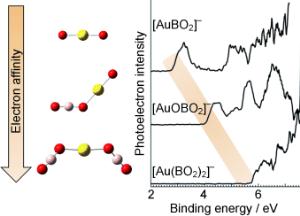
RICHMOND, Va. - An international team of researchers has discovered a new class of highly electronegative chemical species called hyperhalogens, which use superhalogens as building blocks around a metal atom. The new chemical species may have application in many industries.
Researchers from Virginia Commonwealth University, McNeese State University in Lake Charles, La., and the University of Konstanz in Germany report their discovery in the Oct. 6, 2010, international chemistry journal Angewandte Chemie International Edition. The journal designated the paper as "very important," recognition granted to only 5 percent of papers it receives.
Chlorine is one of the elements called halogens, a group that includes fluorine, bromine, and iodine. These chemicals are known for their disinfecting and deodorizing power and are also used in some medications and industrial processes. Researchers say that hyperhalogens could be useful in industries where large amounts of halogens are now needed to make cleaning or decontamination products.
Chemists and physicists like Puru Jena, Ph.D., distinguished professor of physics at VCU, know halogens for their reactivity, a characteristic that makes the halogen elements want to bond with another element or a compound by taking one electron. Chlorine, for example, likes being paired with sodium to make table salt. Sodium wants to give away an electron and chlorine wants to take that electron in what Jena calls "a perfect marriage."
"Halogens only need one electron to reach their happy state," said Jena. "They're much more stable as a negative ion than as a neutral atom."
Once the atom takes an electron and becomes a stable, negative ion, the energy it gains is measured by its electron affinity. In chemistry's periodic table, chlorine has the highest electron affinity, measured at 3.6 electron volts, or eV.
One area of Jena's research focuses on finding ways to make new classes of compounds with large electron affinities.
In 1962, English chemist Neil Bartlett found that platinum hexafluoride reacts with xenon to make a noble gas compound. Scientists were surprised because xenon was one of the stable or "noble" gases that rarely react with other elements. A dozen years later, two Soviet scientists, Gennady Gutsev and Alexander Boldyrev, showed that a larger class of molecules with a metal atom at the center surrounded by halogen atoms, similar to platinum hexafluoride, possesses electron affinities larger than that of chlorine. They termed these molecules "superhalogens."
"For example, you could take a sodium atom and a chlorine atom to make a sodium chloride molecule and then attach a second chlorine atom. That compound would then want another electron because of the extra chlorine," Jena said. "All of a sudden, the electron affinity, which is the characteristic we're after, becomes almost a factor of two larger than that of the chlorine atom. It becomes a superhalogen."
Superhalogens have similar, improved properties as halogens, Jena said.
Jena, together with Anil Kandalam, Ph.D., assistant professor at McNeese State University, theorized that they could push the electron affinity of a cluster or a molecule even higher, by using superhalogens as building blocks, instead of halogens, around a metal atom. The theoretical model was tested through experimental studies led by Gerd F. Ganteför, Ph.D., at the University of Konstanz. They termed these species with unusually large electron affinities as "hyperhalogens."
"We used gold as the metal and surrounded it with two boron-dioxide superhalogens and got a hyperhalogen with an even greater electron affinity," Jena said.
The team's synergistic approach involving theory and experiment produced a gold-borate hyperhalogen with an electron affinity of 5.7 eV. The team now is testing a hyperhalogen constructed with four boron-dioxide superhalogens and have reached an electron affinity of 7 eV, with a goal of building a hyperhalogen with 10 eV. These new hyperhalogens may lead to additional discoveries of novel chemicals, Jena said.
The theoretical investigations for the project were conducted by Jena and graduate student Mary Willis at VCU, along with Kandalam. The experimental work was conducted by Ganteför and graduate student Matthias Götz at the University of Konstanz.
The work was supported in part by the federal Defense Threat Reduction Agency and the Department of Energy.
Further Information:
Mary Willis, Matthias Götz, Prof. Dr. Anil K. Kandalam, Prof. Dr. Gerd F. Ganteför, Prof. Dr. Puru Jena:
Hyperhalogens: Discovery of a New Class of Highly Electronegative Species.
In: Angewandte Chemie International Edition; article first published online 6 Oct 2010, DOI 10.1002/anie.201002212
Source: Virginia Commonwealth University, VCU
Last update: 22.10.2010
Perma link: https://www.internetchemistry.com/news/2010/oct10/hyperhalogens.php
More chemistry: index | chemicals | lab equipment | job vacancies | sitemap
Internetchemistry: home | about | contact | imprint | privacy
© 1996 - 2023 Internetchemistry
